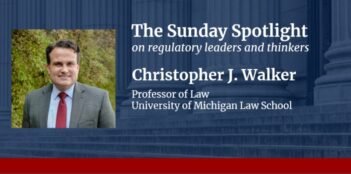
To avoid potential legal challenges, agencies should take even more care in their regulatory planning, review, and communication.
The arrival of the “major questions doctrine” in the U.S. Supreme Court’s West Virginia v. EPA decision has dramatically shifted the legal terrain atop which federal agencies regulate—and has left regulators perplexed about how to move forward.
For a certain class of “major questions” cases involving agency interpretation of statutes, the doctrine has effectively usurped the once-deferential Chevron regime that granted federal agencies wide latitude in statutory interpretation. According to the majority opinion in West Virginia, courts can identify these “major questions” cases by analyzing “the history and breadth of the authority that the agency has asserted, and the economic and political significance of that assertion.” If a court concludes that an agency action poses a major question, the regulation will only survive if the government can point to “clear congressional authorization” for it, which requires “something more than a merely plausible textual basis.”
The major questions doctrine poses a grave—and, in our opinion, misguided—obstacle to administrative policymaking. But the worst possible response would be for federal agencies to freeze new regulatory initiatives in the face of it. With that in mind, our purpose in this essay is to help agency officials adapt to this new era in federal rulemaking—even if much about the doctrine’s future applications remains nebulous.
As a more detailed report by our organization, Governing for Impact, reveals, the emergence of the major questions doctrine will impact at least three different aspects of the regulatory process: planning regulatory agendas; drafting and reviewing rulemaking documents; and strategizing agency communications.
First, regulators should map out regulatory agendas with the major questions doctrine in mind. For example, when the U.S. Congress grants agencies new regulatory authority in the future, agencies should use that authority maximally. For newly enacted statutes, near-contemporaneous interpretations by an agency appear to hold a special precedential value under the major questions doctrine. As the majority in West Virginia states, “just as established practice may shed light on the extent of power conveyed by general statutory language, so the want of assertion of power by those who presumably would be alert to exercise it, is equally significant in determining whether such power was actually conferred.” In the heat of the moment, political considerations may weigh in favor of agencies pursuing a less-controversial, moderated course. But preserving the broadest range of agency authority in the future might instead require adopting a maximal interpretation from the start.
When using an older statute, by contrast, regulators should consider sequencing regulatory actions on their agenda such that uses of “novel” authority are not politically or economically significant. In West Virginia, the majority seems to hold that, to raise a major question, agency action must both involve a novel use of statutory authority and be economically or politically significant. It might therefore behoove agencies considering multiple regulations under the same statute to sequence regulations such that the first uses of a novel or rarely used authority are politically and economically modest. These “insignificant” regulations can subsequently provide a precedential foundation for more ambitious regulations.
Second, regulators should revise their processes for writing and reviewing rulemaking documents. The federal government should revamp how it vets important regulations. The current complex dialogue among understaffed agencies, the Office of Information and Regulatory Affairs, and the U.S. Department of Justice can create problems when drafting regulations.
One potential solution, especially for high-profile rules or Administration priorities, could be for the White House to detail a team of regulatory law and policy experts, perhaps some combination of Justice Department career lawyers and political appointees, to the Office of Management and Budget to expedite legal reviews and sharpen legal analysis from the get-go. This “fly team” could add vital capacity earlier in the rulemaking process, thereby facilitating quicker and more effective collaboration among government stakeholders.
Agencies should also include strong legal justifications in preliminary rulemaking documents. The Administrative Procedure Act generally requires that agencies, before issuing a rule, publish a notice of proposed rulemaking in the Federal Register. Historically, this requirement has been relatively perfunctory. In the current environment, however, it may be advisable for agencies to instead include well-developed legal justifications in these notices. Articulating a clear legal justification will have the benefit of eliciting counterarguments early, giving agencies the opportunity to respond to them on the record in the final rule.
In final rulemaking documents, agencies should analogize to past regulations. Under the major questions doctrine, some courts will treat new or novel exercises of longstanding authority with extreme skepticism. By the test laid out in West Virginia, analogizing current rules to past regulatory efforts should strengthen the case for upholding them.
Depending on the rule at issue, the agency might analogize to either the mechanism or object of regulation under past rules. Policymakers might also consider comparing the regulatory effects of new rules to those of previous regulations to demonstrate that the agency has used the same statutory authority in ways that have the same or greater significance.
Agencies should also be careful to avoid a new Chevron trap. Given the deference traditionally owed to agency interpretations under the Chevron regime, agency lawyers may be tempted in final rule documents or litigation to characterize a statutory provision as “ambiguous.” But statutory ambiguity or vagueness may now provide fodder for a major questions doctrine challenge, thereby subjecting the rule to more judicial scrutiny, not less. As a result, it is probably best for agencies to outline what they think is the best articulation of the scope of agency authority, without trying to claim Chevron deference overtly.
Finally, agencies and the White House should adopt effective communications strategies to support—or at least to avoid undermining—their rulemaking efforts. In Justice Neil Gorsuch’s West Virginia concurrence, but arguably in the majority opinion as well, it appears that the major questions doctrine test has effectively made an administration’s communications strategy part of the rulemaking record. This record, of course, includes documents the agency publishes in the Federal Register. But less intuitively, after West Virginia, it may also include informal communications including press statements, White House or agency fact sheets, and remarks from the President, cabinet members, and prominent administration staffers.
As a result, policymakers—whether in the executive branch or Congress—should tread carefully when making remarks about regulations. An administration that was seeking to minimize the risk of a major questions doctrine challenge to an important executive action should probably avoid using terms such as “whole of government approach,” “novel,” “unprecedented,” “sweeping,” “broad,” and “vague.” Nor should it imply that it is resorting to executive action only because Congress has refused to act on the issue. Instead, it should always emphasize that an agency is duly acting within a clear limiting principle, and try to characterize the action as routine, or the natural analog to past agency practice.
Although legal uncertainty around the major questions doctrine may tempt regulators to shrink their ambitions, resolving complex societal issues requires meaningful executive branch policymaking. By attentive action in three areas—strategic regulatory planning, rulemaking review, and coordinated communications—policymakers can put regulations on stronger legal footing and continue to develop regulations that will protect the public.






